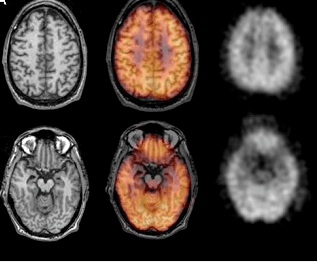Frontotemporal dementia and parkinsonism linked to chromosome 17
| Frontotemporal dementia and parkinsonism linked to chromosome 17 | |
|---|---|
 | |
| This condition is inherited in an autosomal dominant manner. | |
Frontotemporal dementia and parkinsonism linked to chromosome 17 (FTDP-17) is an autosomal dominant neurodegenerative tauopathy and Parkinson plus syndrome.[1] FTDP-17 is caused by mutations in the MAPT (microtubule associated protein tau) gene located on the q arm of chromosome 17, and has three cardinal features: behavioral and personality changes, cognitive impairment, and motor symptoms. FTDP-17 was defined during the International Consensus Conference in Ann Arbor, Michigan, in 1996.
Signs and symptoms
The clinical presentation of FTDP-17 is as follows:[2]
- Cognitive deficit
- Behavioral problems
- Motor dysfunction
Pathophysiology
The pathogenetic mechanisms underlying the disorder are thought to be related to the altered proportion of tau isoforms or to the ability of tau to bind microtubules and to promote microtubule assembly.[citation needed]
Diagnosis

Definitive diagnosis of FTDP-17 requires a combination of characteristic clinical and pathological features and molecular genetic analysis. Genetic counseling should be offered to affected and at-risk individuals; for most subtypes, penetrance is incomplete.[citation needed]
Management
Currently, treatment for FTDP-17 is only symptomatic and supportive.[citation needed]
Prognosis
The prognosis and rate of the diseases progression vary considerably among individual patients and genetic kindreds, ranging from life expectancies of several months to several years, and, in exceptional cases, as long as two decades.[citation needed]
Epidemiology
The prevalence and incidence remain unknown but FTDP-17 is an extremely rare condition. It is caused by mutations in the MAPT gene, which encodes a microtubule-binding protein. Over 100 families with 38 different mutations in the tau gene have been identified worldwide. The phenotype of FTDP-17 varies not only between families carrying different mutations but also between and within families carrying the same mutations.[citation needed]
References
- ↑ Mitra K, Gangopadhaya PK, Das SK. (Jun 2003). "Parkinsonism plus syndrome--a review". Neurology India. 51 (2): 183–8. PMID 14570999.
{{cite journal}}: CS1 maint: uses authors parameter (link) - ↑ 2.0 2.1 Wszolek, Zbigniew K; Tsuboi, Yoshio; Ghetti, Bernardino; Pickering-Brown, Stuart; Baba, Yasuhiko; Cheshire, William P (December 2006). "Frontotemporal dementia and parkinsonism linked to chromosome 17 (FTDP-17)". Orphanet Journal of Rare Diseases. 1 (1): 30. doi:10.1186/1750-1172-1-30. Retrieved 27 December 2022.
Further reading
- Zbigniew K Wszolek, Yoshio Tsuboi, Bernardino Ghetti, Stuart Pickering-Brown, Yasuhiko Baba and William P Cheshire Orphanet Journal of Rare Diseases 2006, 1:30 doi:10.1186/1750-1172-1-30
- Luc Buée; André Delacourte (1999). "Comparative Biochemistry of Tau in Progressive Supranuclear Palsy, Corticobasal Degeneration, FTDP-17 and Pick's Disease" (PDF). Brain Pathology. 9 (4): 681–693. doi:10.1111/j.1750-3639.1999.tb00550.x. PMC 8098140. PMID 10517507.[permanent dead link]
External links
| Classification |
|---|
- Pages with script errors
- CS1 maint: uses authors parameter
- All articles with unsourced statements
- Articles with unsourced statements from July 2021
- Articles with invalid date parameter in template
- Articles with unsourced statements from September 2021
- All articles with dead external links
- Articles with dead external links from December 2019
- Articles with permanently dead external links
- Neurodegenerative disorders
- Brain disorders
- Cognitive disorders
- Genetic disorders with no OMIM